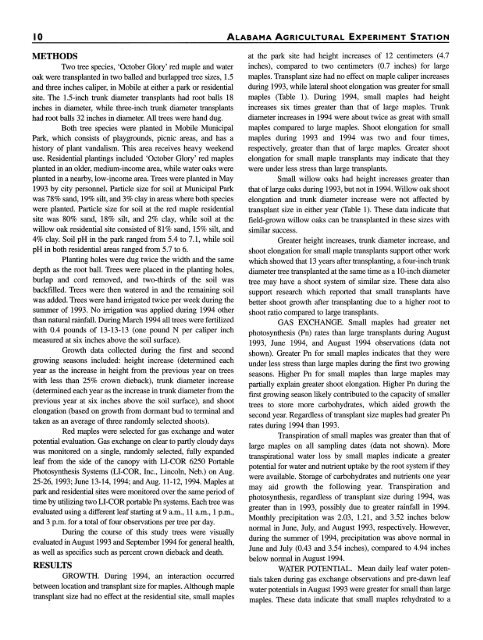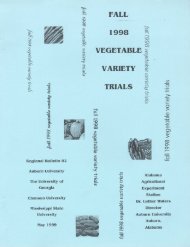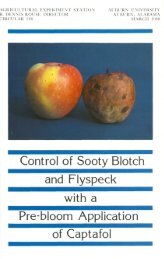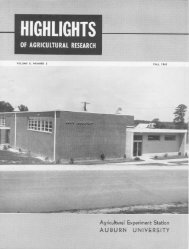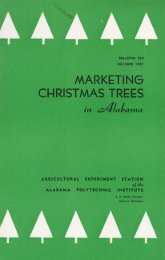1997 Ornamentals Research Report - AUrora - Auburn University
1997 Ornamentals Research Report - AUrora - Auburn University
1997 Ornamentals Research Report - AUrora - Auburn University
You also want an ePaper? Increase the reach of your titles
YUMPU automatically turns print PDFs into web optimized ePapers that Google loves.
I0 ALABAMA AGRICULTURAL ExPERIMENT STATION<br />
ALABAMA AGRICULTURAL EXPERIMENT STATION<br />
I0<br />
METHODS<br />
Two tree species, 'October Glory' red maple and water<br />
oak were transplanted in two balled and burlapped tree sizes, 1.5<br />
and three inches caliper, in Mobile at either a park or residential<br />
site. The 1.5-inch trunk diameter transplants had root balls 18<br />
inches in diameter, while three-inch trunk diameter transplants<br />
had root balls 32 inches in diameter. All trees were hand dug.<br />
Both tree species were planted in Mobile Municipal<br />
Park, which consists of playgrounds, picnic areas, and has a<br />
history of plant vandalism. This area receives heavy weekend<br />
use. Residential plantings included 'October Glory' red maples<br />
planted in an older, medium-income area, while water oaks were<br />
planted in a nearby, low-income area. Trees were planted in May<br />
1993 by city personnel. Particle size for soil at Municipal Park<br />
was 78% sand, 19% silt, and 3% clay in areas where both species<br />
were planted. Particle size for soil at the red maple residential<br />
site was 80% sand, 18% silt, and 2% clay, while soil at the<br />
willow oak residential site consisted of 81% sand, 15% silt, and<br />
4% clay. Soil pH in the park ranged from 5.4 to 7.1, while soil<br />
pH in both residential areas ranged from 5.7 to 6.<br />
Planting holes were dug twice the width and the same<br />
depth as the root ball. Trees were placed in the planting holes,<br />
burlap and cord removed, and two-thirds of the soil was<br />
backfilled. Trees were then watered in and the remaining soil<br />
was added. Trees were hand irrigated twice per week during the<br />
summer of 1993. No irrigation was applied during 1994 other<br />
than natural rainfall. During March 1994 all trees were fertilized<br />
with 0.4 pounds of 13-13-13 (one pound N per caliper inch<br />
measured at six inches above the soil surface).<br />
Growth data collected during the first and second<br />
growing seasons included: height increase (determined each<br />
year as the increase in height from the previous year on trees<br />
with less than 25% crown dieback), trunk diameter increase<br />
(determined each year as the increase in trunk diameter from the<br />
previous year at six inches above the soil surface), and shoot<br />
elongation (based on growth from dormant bud to terminal and<br />
taken as an average of three randomly selected shoots).<br />
Red maples were selected for gas exchange and water<br />
potential evaluation. Gas exchange on clear to partly cloudy days<br />
was monitored on a single, randomly selected, fully expanded<br />
leaf from the side of the canopy with LI-COR 6250 Portable<br />
Photosynthesis Systems (LI-COR, Inc., Lincoln, Neb.) on Aug.<br />
25-26, 1993; June 13-14, 1994; and Aug. 11-12, 1994. Maples at<br />
park and residential sites were monitored over the same period of<br />
time by utilizing two LI-COR portable Pn systems. Each tree was<br />
evaluated using a different leaf starting at 9 a.m., 11 a.m., 1 p.m.,<br />
and 3 p.m. for a total of four observations per tree per day.<br />
During the course of this study trees were visually<br />
evaluated in August 1993 and September 1994 for general health,<br />
as well as specifics such as percent crown dieback and death.<br />
RESULTS<br />
GROWTH. During 1994, an interaction occurred<br />
between location and transplant size for maples. Although maple<br />
transplant size had no effect at the residential site, small maples<br />
at the park site had height increases of 12 centimeters (4.7<br />
inches), compared to two centimeters (0.7 inches) for large<br />
maples. Transplant size had no effect on maple caliper increases<br />
during 1993, while lateral shoot elongation was greater for small<br />
maples (Table 1). During 1994, small maples had height<br />
increases six times greater than that of large maples. Trunk<br />
diameter increases in 1994 were about twice as great with small<br />
maples compared to large maples. Shoot elongation for small<br />
maples during 1993 and 1994 was two and four times,<br />
respectively, greater than that of large maples. Greater shoot<br />
elongation for small maple transplants may indicate that they<br />
were under less stress than large transplants.<br />
Small willow oaks had height increases greater than<br />
that of large oaks during 1993, but not in 1994. Willow oak shoot<br />
elongation and trunk diameter increase were not affected by<br />
transplant size in either year (Table 1). These data indicate that<br />
field-grown willow oaks can be transplanted in these sizes with<br />
similar success.<br />
Greater height increases, trunk diameter increase, and<br />
shoot elongation for small maple transplants support other work<br />
which showed that 13 years after transplanting, a four-inch trunk<br />
diameter tree transplanted at the same time as a 10-inch diameter<br />
tree may have a shoot system of similar size. These data also<br />
support research which reported that small transplants have<br />
better shoot growth after transplanting due to a higher root to<br />
shoot ratio compared to large transplants.<br />
GAS EXCHANGE. Small maples had greater net<br />
photosynthesis (Pn) rates than large transplants during August<br />
1993, June 1994, and August 1994 observations (data not<br />
shown). Greater Pn for small maples indicates that they were<br />
under less stress than large maples during the first two growing<br />
seasons. Higher Pn for small maples than large maples may<br />
partially explain greater shoot elongation. Higher Pn during the<br />
first growing season likely contributed to the capacity of smaller<br />
trees to store more carbohydrates, which aided growth the<br />
second year. Regardless of transplant size maples had greater Pn<br />
rates during 1994 than 1993.<br />
Transpiration of small maples was greater than that of<br />
large maples on all sampling dates (data not shown). More<br />
transpirational water loss by small maples indicate a greater<br />
potential for water and nutrient uptake by the root system if they<br />
were available. Storage of carbohydrates and nutrients one year<br />
may aid growth the following year. Transpiration and<br />
photosynthesis, regardless of transplant size during 1994, was<br />
greater than in 1993, possibly due to greater rainfall in 1994.<br />
Monthly precipitation was 2.03, 1.21, and 3.52 inches below<br />
normal in June, July, and August 1993, respectively. However,<br />
during the summer of 1994, precipitation was above normal in<br />
June and July (0.43 and 3.54 inches), compared to 4.94 inches<br />
below normal in August 1994.<br />
WATER POTENTIAL. Mean daily leaf water potentials<br />
taken during gas exchange observations and pre-dawn leaf<br />
water potentials in August 1993 were greater for small than large<br />
mapes Tes daa ndcae hatsmllmale reydatd o


